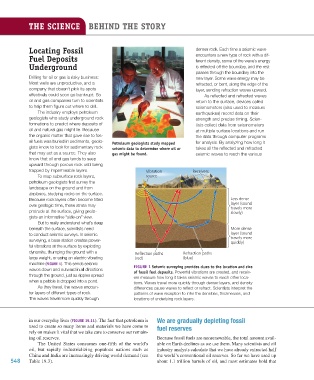Page 549 - Environment: The Science Behind the Stories
P. 549
THE SCIENCE BEHIND THE STORY
Locating Fossil denser rock. Each time a seismic wave
Fuel Deposits encounters a new type of rock with a dif-
ferent density, some of the wave’s energy
Underground is reflected off the boundary, and the rest
passes through the boundary into the
Drilling for oil or gas is risky business: new layer. Some wave energy may be
Most wells are unproductive, and a refracted, or bent, along the edge of the
company that doesn’t pick its spots layer, sending refraction waves upward.
effectively could soon go bankrupt. So As reflected and refracted waves
oil and gas companies turn to scientists return to the surface, devices called
to help them figure out where to drill. seismometers (also used to measure
The industry employs petroleum earthquakes) record data on their
geologists who study underground rock strength and precise timing. Scien-
formations to predict where deposits of tists collect data from seismometers
oil and natural gas might lie. Because at multiple surface locations and run
the organic matter that gave rise to fos- the data through computer programs
sil fuels was buried in sediments, geolo- Petroleum geologists study mapped for analysis. By analyzing how long it
gists know to look for sedimentary rock seismic data to determine where oil or takes all the reflected and refracted
that may act as a source. They also gas might be found. seismic waves to reach the various
know that oil and gas tends to seep
upward through porous rock until being
trapped by impermeable layers. Vibration Receivers
To map subsurface rock layers, source
petroleum geologists first survey the
landscape on the ground and from
airplanes, studying rocks on the surface.
Because rock layers often become tilted Less dense
over geologic time, these strata may layer (sound
travels more
protrude at the surface, giving geolo- slowly)
gists an informative “side-on” view.
But to really understand what’s deep
beneath the surface, scientists need More dense
to conduct seismic surveys. In seismic layer (sound
surveying, a base station creates power- travels more
quickly)
ful vibrations at the surface by exploding
dynamite, thumping the ground with a Reflection paths Refraction paths
large weight, or using an electric vibrating (red) (blue)
machine (FIGURE 1). This sends seismic
waves down and outward in all directions FIGURE 1 Seismic surveying provides clues to the location and size
of fossil fuel deposits. Powerful vibrations are created, and receiv-
through the ground, just as ripples spread ers measure how long it takes seismic waves to reach other loca-
when a pebble is dropped into a pond. tions. Waves travel more quickly through denser layers, and density
As they travel, the waves encoun- differences cause waves to reflect or refract. Scientists interpret the
ter layers of different types of rock. patterns of wave reception to infer the densities, thicknesses, and
The waves travel more quickly through locations of underlying rock layers.
in our everyday lives (FIGURE 19.11). The fact that petroleum is We are gradually depleting fossil
used to create so many items and materials we have come to fuel reserves
rely on makes it vital that we take care to conserve our remain-
ing oil reserves. Because fossil fuels are nonrenewable, the total amount avail-
The United States consumes one-fifth of the world’s able on Earth declines as we use them. Many scientists and oil
oil, but rapidly industrializing populous nations such as industry analysts calculate that we have already extracted half
China and India are increasingly driving world demand (see the world’s conventional oil reserves. So far we have used up
548 Table 19.3). about 1.1 trillion barrels of oil, and most estimates hold that
M19_WITH7428_05_SE_C19.indd 548 12/12/14 5:23 PM

